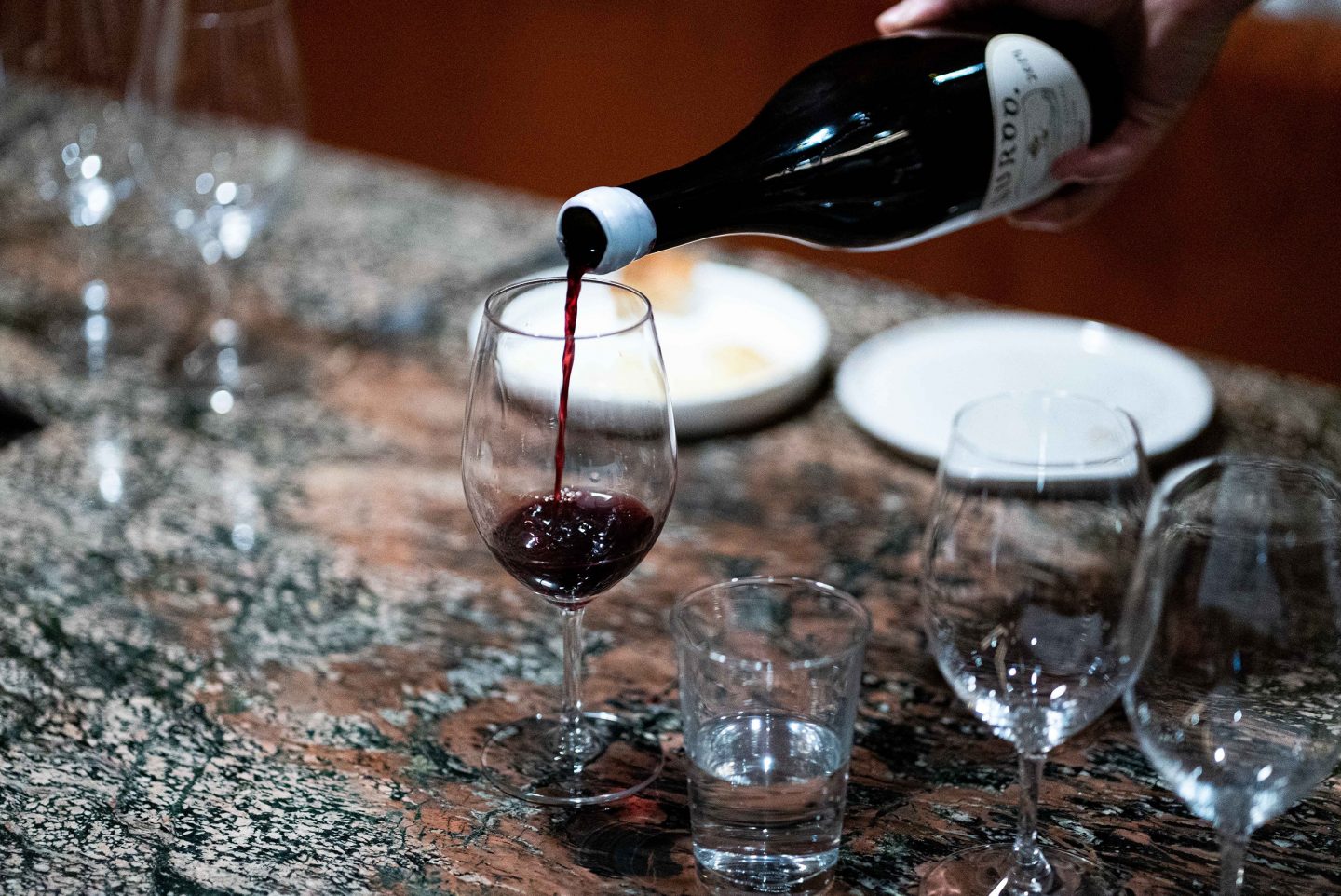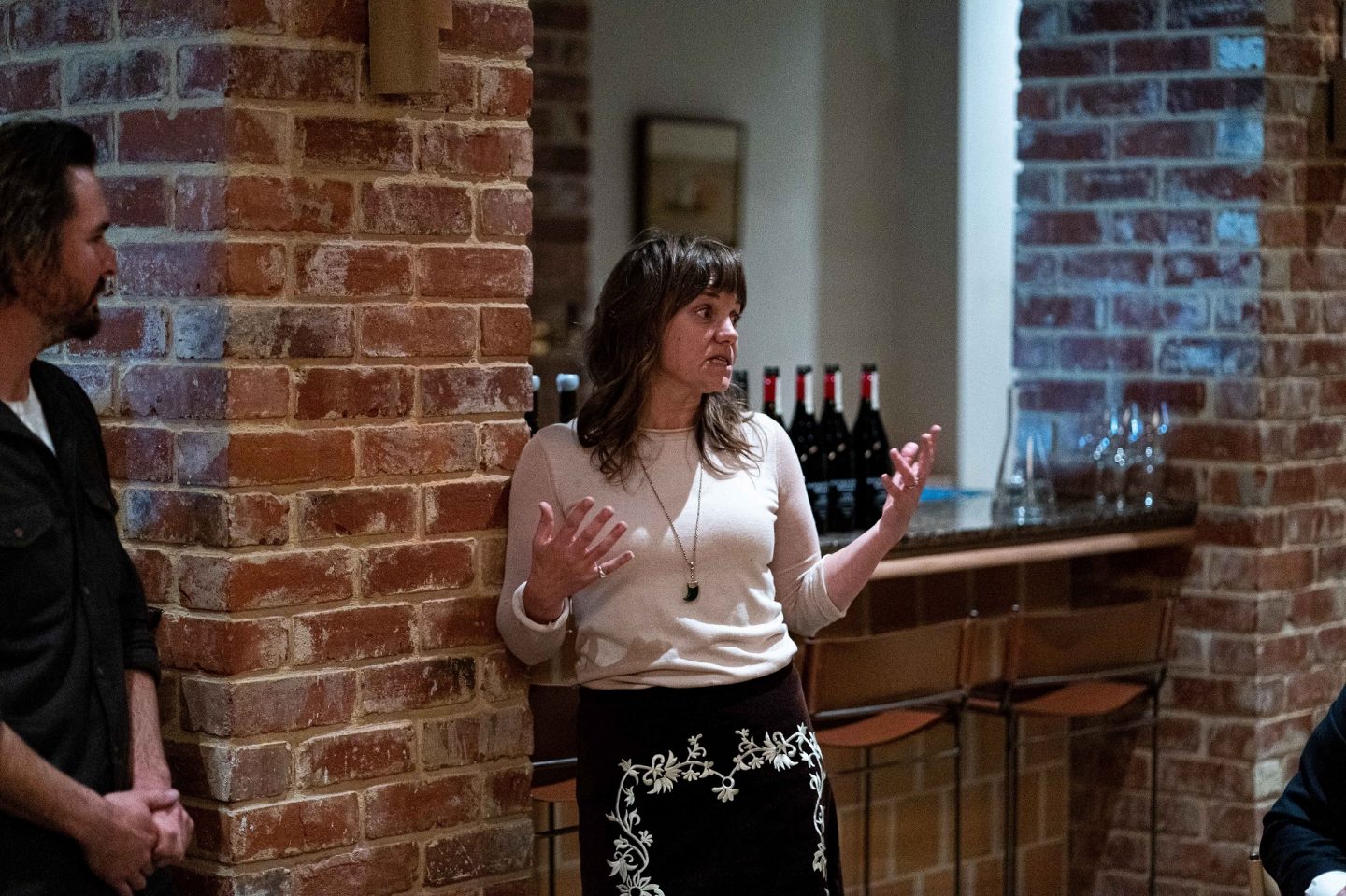Rebirth of the cool climate

Hot 100 Wines alumni Charlotte Hardy of Charlotte Dalton Wines and Nick Dugmore of The Stoke Wines are redefining just how cool Kangaroo Island wine can be.
The aftermath of the 2020 bushfires signals a new beginning for Kangaroo Island’s wine industry. With about a third of the island’s 10,000 hectares of vines having been torched by the January fires, there is a determination and commitment to replant. The question is, what grape varieties will best serve the island into the future?
Nick Dugmore is driving the discussion. This wily young winemaker, formerly of Wirra Wirra in McLaren Vale, has bought a vineyard on Kangaroo Island with his wife Rebecca, and their affection for this cool-climate region, buffeted by chilly Southern Ocean winds, is celebrated on the labels of their brand, The Stoke Wines.
Dugmore is excited that Kangaroo Island can rise as a new home of modern wine styles, but he notes that the first wave of Kangaroo Island grape plantings during the 1990s resulted in a piecemeal assortment of more than 20 grape varieties, without conclusive evidence of which best suits the island’s particular soils and weather patterns.
Several of these vineyards are now burned, and many more contained within larger sheep and grain farms have been neglected as forgotten investments, although Dugmore says interest in new grape plantings is rising – and he hopes the catalyst for continued regeneration will be his ambitious Guroo project. Guroo has him inviting celebrated winemakers from SA’s leading wine regions to produce limited-release wines with parcels of specific grape varieties from Kangaroo Island, with each winemaker producing wines from three consecutive vintages. This invitational initiative is designed to promote the potential of Kangaroo Island fruit to a wider fraternity of innovative modern winemakers – and identify which grapes can emerge as a vinous signature for Kangaroo Island.
The Guroo project has kicked around in Dugmore’s mind for about five years, its name derived from maritime explorer Captain Matthew Flinders’ abbreviated description of Kangaroo Island in his 1802 diary. Dugmore loves the term’s playful way of heralding both the island source of the fruit for these wines, and the expertise of winemakers involved in the project. Dugmore approached Hardy to be involved in the first Guroo project after her Charlotte Dalton Syrah won best wine at the 2018 Adelaide Hills Wine Show. He realised that her innovative take on lighter, livelier red wines would be ideally suited to Kangaroo Island’s shiraz grapes.
“I immediately said yes to Nick’s idea because it presented me with a great opportunity to learn something new,” says Hardy. “I had never been to the island before, so Nick was going to introduce me to something that had great possibility. As a curious winemaker, this was irresistible.”
Hardy obtained two tonnes of shiraz grapes from False Cape’s 20-year-old vineyard on the Dudley Peninsula in the western lobe of the island. She has accessed the same four rows for three successive vintages from 2019. This has allowed her to examine vintage differences in fruit from the same source.
While she was not on the island during vintage, Hardy instructed Dugmore (who was on the island) to ensure that the fruit was picked early when the sugars were low. Hardy then had the berries transported to her Port Elliot winery for crushing and fermentation, although she chose to retain about 50 per cent whole-bunch berries in the fermentation tank, to ensure her preference for bright fruit and high perfume in a lean, taut wine.
Curiously, her instinct of what to expect from the Kangaroo Island grapes proved incorrect. “I thought they’d be very similar to the cool-climate fruit that I access from the Adelaide Hills, but it was significantly different,” she says. “There was a lot more spiciness than I expected, and the grapes retained terrific acidity, even though their flavours had developed, and the grape stalks were brown rather than green. I used all of this to my advantage.”

The finished wine – Guroo 2019 Shiraz ($50, available from guroowines. com.au) – stands as a valid companion to the Charlotte Dalton Adelaide Hills Syrah, exhibiting the same type of lively energy and nervous tension, but with more pepper, nutmeg and cinnamon biting in the tail.
Fittingly, it was launched at the first Tasting Australia Local event in late July – a Kangaroo Island–themed dinner in Fino Vino restaurant, as part of a series of 20 Tasting Australia Local showcases designed to fill a void left by the cancelled 2020 festival. Served in the company of a four-course meal featuring Kangaroo Island oysters, marron, baby abalone, lamb, broad beans and olive oil – prepared by Fino Vino’s David Swain and Tasting Australia director Simon Bryant – the Guroo wine shone at the table, in the company of a suite of other impressive Kangaroo Island wines. The event also delivered an announcement. In 2021, the next Guroo winemaker will commence a different wine project; Stephen George, of Ashton Hills, will work with Kangaroo Island pinot noir. “I had no idea that pinot noir was being grown on Kangaroo Island – and that’s why it’s so exciting,” says George. “It’s why I said yes to being involved in discovering a region I know nothing about – to learn.”
The Guroo project serves as an entrée for consumers to investigate several other Kangaroo Island wine offerings being produced by mainland wine companies. This includes The Other Wine company, a venture by Shaw+Smith Wines that allows winemaker Adam Wadewitz the freedom to explore new ideas by purchasing fruit outside the company’s own vineyards. He chose a parcel of cabernet franc from The Islander Estate’s vineyard in central Kangaroo Island.
Those vines have now tragically been burnt by bushfire, but the resulting wine (The Other Wine Co 2019 Cabernet Franc, $35) is exciting and elegantly perfumed, supple and luscious on the palate. Several pundits are touting this grape variety as the potential standard bearer for Kangaroo Island wine – even though there is now only one small surviving plot of cabernet franc on the island, located within the Dugmore family vineyard. More plantings are predicted.
There are strong mainland links to several other Kangaroo Island wine offerings.
Springs Road Wines is the brainchild of winemaker/viticulturist Joch Bosworth and his wife Louise Hemsley-Smith; it’s a companion label to their Battle of Bosworth winery at McLaren Vale. In 2017, they purchased a vineyard that had been planted in 1994, and there they make a range of five wines (the ace in the pack being their shiraz/cabernet blend, $30) . They’ve now opened a cellar door at Cygnet River. This is an important link in a growing gourmet neighbourhood near the Kingscote airport, which also includes tasting rooms for KI Spirits and The Islander Estate wines.
Elsewhere on the island, the Helyar and Follett family’s 20-hectare False Cape vineyard produces a classic line in cool -climate cabernet sauvignon, merlot, shiraz and sauvignon blanc. False Cape wines are made at the Follett s’ Lake Breeze winery in Langhorne Creek, but the fruits of this endeavour can be sampled at the Cellar Door Tasting Room that opened in early 2020, located beside the vineyard.
This forms a convenient wine-tasting circuit on the Dudley Peninsula not too far from Dudley Wines’ purpose-built tasting room, located on the Howard family’s farm outside Penneshaw. It presents the brand’s 14 wines beside casual lunch options (the whiting pizza is renowned), served on expansive decks perched high above Backstairs Passage. It has become a drawcard for tourists alighting from the Cape Jarvis –Penneshaw ferry.
Maxwell Wines in McLaren Vale has produced a single vineyard shiraz from its vineyard near Stokes Bay for many years, although these vines were also razed by the 2020 bushfi res. Winery proprietor Mark Maxwell is keen to keep sourcing KI fruit to ensure the continuation of this release.
Others include Bay of Shoals vineyard near Kingscote, which has a charming nautical-themed cellar door tasting room designed by local artist Bernie Walsh (who also drew the brand’s distinctive pelican labels). Planted in 1993, the vineyard produces a steely riesling and crisp savagnin as standouts among a diverse portfolio.
Caj Amadio – the former Adelaide builder-turned-winemaker who also planted the Chain of Ponds and Kersbrook vineyards in the northern Adelaide Hills – was among the first supporters of Kangaroo Island vines, and his family wine company still sources fruit from the Florance Vineyard near Cygnet River, with Amadio Wines producing the Kangaroo Island Trading Company wines, available from the cellar door tasting room and eatery in the heart of Kingscote.
The most important cog in the rise of Kangaroo Island’s wine industry is The Islander Estate, the 12-hectare vineyard of famed Bordeaux winemaker Jacques Lurton. His excellent wine brand has become a beacon that showed off the island’s vinous excellence to an international audience.
While his malbec, cabernet franc, grenache, shiraz, sangiovese, Semillon and chardonnay vines were engulfed by the fires, staff at the winery took smart precautions and moved the 2019 vintage wines in barrel to a safe storage site in the eastern part of Kangaroo Island. It means they still have wines available for sale at the winery’s tasting room at Cygnet River, about 25 kilometres east of the vineyard, which was untouched by the fires.
“The vines are tough, and we are putting the work in to try to repair and restore the vineyard,” says Yale Norris, general manager and Lurton’s co-owner in The Islander Estate. “We will not have a 2020 vintage but we fully expect to have plans in place for sourcing grapes for vintage 2021 and beyond.”
Advice from viticulture expert Toby Bekker s (of Bekkers Wines, who helped plant The Islander Estate vineyard in 2000) and the team at Shaw + Smith have Norris and Lurton confident of reviving the vineyard.
